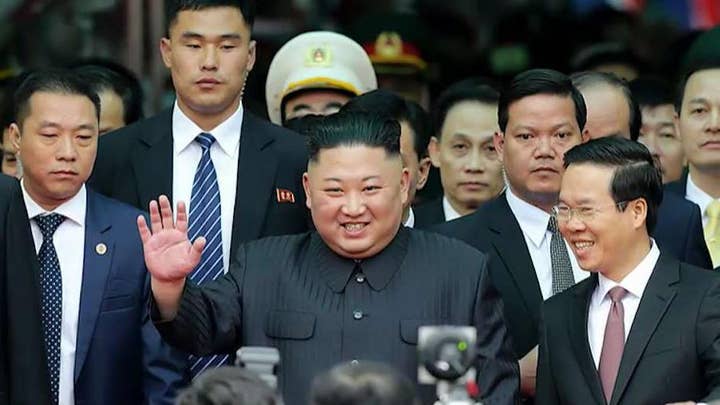Esper on North Korea: Full array of forces 'ready to fight tonight'
Mark Esper, Defense Secretary, discusses the path forward on nuclear negotiations with North Korea
North Korean leader Kim Jong Un ended his government’s moratorium on long-range missile and nuclear weapon testing this week and vowed he would soon display a new “strategic weapon.” The move came after a threat of a “Christmas gift” for the United States. That didn’t materialize.
As a result, Democrats who used to favor diplomacy above force will call President Trump’s policy toward North Korea and personal engagement with Kim a failure. So too will Trump’s interventionist opponents on the right.
But these critics overlook the miserable situation Trump inherited and what can still be accomplished through diplomacy and the use of national power short of war.
KIM JONG UN THREATENS TO RENEW TESTING NUCLEAR WEAPONS, LONG-RANGE MISSILES
Trump began his term with a North Korea that had already conducted five nuclear tests. Early in Trump’s term, North Korea conducted its sixth and most powerful nuclear test, and successfully flew an ICBM with a dummy warhead that could theoretically hit America.
This situation awaited Trump because the Clinton, Bush and Obama administrations had all failed miserably at managing the North Korean threat.
In light of Kim’s announcement this week, Trump should adjust his tactics to pressure China more to get North Korea to negotiate seriously, while continuing his own high-level diplomacy.
Obama simply ignored the situation, professing a policy of “strategic patience” that could have just as easily used the “Hope” motto of his 2008 campaign.
Clinton considered an airstrike, but opted instead to pay huge sums to Pyongyang under the guise of “energy assistance.”
President George W. Bush also tried to pay off Pyongyang for its nuclear program by unfreezing sanctioned money and providing energy assistance and food aid the regime easily monetized. In both cases, North Korea took the money but never gave up its nuclear capabilities.
Given this lamentable history, President Trump understandably chose to take a different path that included displays of military power in conjunction with our Japanese and South Korean allies, expanded sanctions, and three separate meetings with Kim.
More from Opinion
- Harry Kazianis: North Korea's Kim has THIS goal in mind (no, he's not crazy). Here's how Trump should respond
- Richard Manning: Trade dominates economic agenda – 2020 won't be all impeachment and elections
- Kayleigh McEnany: Trump winning, Democrats whining — president achieved in 2019 despite obstruction
In light of Kim’s announcement this week, Trump should adjust his tactics to pressure China more to get North Korea to negotiate seriously, while continuing his own high-level diplomacy.
There is a temptation to conduct another modest show of force against North Korea in response to a provocation.
In recent years, such displays have included redirecting a U.S. aircraft carrier to the area and fly-bys of allied aircraft. While not irrelevant, North Korea is accustomed to these demonstrations and realizes they will not result in the actual use of force.
North Korea’s nuclear program is too developed and diffuse to terminate militarily without a costly, high-risk invasion and occupation that no one wants.
A better option is to alter the balance of power in our favor while giving Beijing an incentive to pressure its North Korean ally. Even more than North Korea, China hated the 2017 deployment to South Korea of the U.S.-built Terminal High Altitude Air Defense (THAAD) system. THAAD can shoot down Chinese missiles in addition to North Korean ones, and therefore degrades China’s offensive and deterrent capabilities.
CLICK HERE TO GET THE OPINION NEWSLETTER
We should pressure the South Korean government to purchase more THAAD inceptor missiles. This would remind Beijing that the misconduct of its North Korean cousin will diminish its own strategic position, hopefully leading to Chinese pressure on North Korea to negotiate with us in good faith.
If South Korea refuses to cooperate, Trump could order the expansion take place on the U.S. island of Guam. Or he could negotiate with Japan to deploy THAAD in Okinawa and accelerate the deployment of the even-more-sophisticated Aegis Ashore missile-defense system we are selling to Tokyo.
More provocatively, he could reverse the 1991 decision by President George H. W. Bush to remove nuclear-armed cruise missiles from our attack submarines. The relevant Tomahawk missiles would have to be rebuilt; the W80 nuclear warheads still exist. Both China and Russia would put much pressure on North Korea to forestall a U.S. move like this.
Trump should also apply more pressure directly to North Korea by ordering a reluctant and over-lawyered Pentagon to have the U.S. Navy and Coast Guard halt foreign ships conducting illegal smuggling of oil and coal.
Just as important, Trump should continue his historic personal diplomacy with Kim.
Summits between the two leaders are often productive but subsequent lower-level meetings intended to develop specific disarmament actions are not. The North’s negotiators refuse to disarm first and ours refuse to repeat past failures by easing sanctions and offering aid first.
CLICK HERE TO GET THE FOX NEWS APP
The two leaders will have to hammer out a framework for denuclearization themselves, agreeing on the timing of disarmament steps and sanctions relief. A deal that removes North Korea’s fissionable uranium-235 and plutonium-239 would be a radical breakthrough.
Trump deserves credit for trying diplomacy with the North Koreans and he should keep trying. He can’t possibly do worse than his predecessors.



